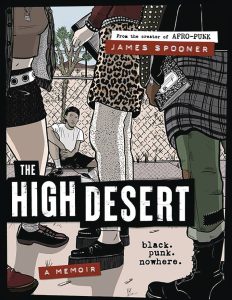 The High Desert
The High Desert
Creator: James Spooner
Publisher: HarperCollins Books
Before the internet started raising us, there were the 90s. We had cassettes (who could afford a CD?), a too comfortable relationship with casual racism and homophobia, and hoped our friends were at home when we rang the doorbell, our parents waiting in the idling car nearby. Skateboarding was cool. VHS still ruled. It was before Napster, before streaming music, where we had to hope the cashier at the record store was cool enough to suggest something decent. At the intersection of all these things were punk rock thrived, also lies James Spooner’s graphic memoir, The High Desert.
James Spooner is best known as the director of the seminal documentary, Afro-Punkand co-creator of the Afropunk Festival. The High Desert, his first graphic novel, focuses on the year as a young teenager when he lived in Apple Valley, California. During this year, he discovers the punk scene, shifting his identity and setting up the rest of his life. This book is a complicated reflection on those experiences that shaped Spooner’s life and an honest recounting of the young man he used to be.
This graphic memoir works with the classic coming of age framework with the punk scene of the time as the backdrop. At its very heart, The High Desert is about how James Spooner grows into the man he is at the time of writing. The teenage angst, the loneliness drawn out on full two page splashes of landscape, the rebellion, and the music; it’s the perfect mix that brings Spooner’s memoir to life.
The hyper specificity of the music, style, and space is half of the joy of Spooner’s book. With ribbons of music playing inside and between panels, Spooner helpfully cites the songs on the page for our further listening pleasure. In addition, the desert, and the overwhelming whiteness of Apple Valley, gives the story a hyper specific backdrop that Spooner uses deliberately to add to his experiences, with impressive moments of visual metaphor throughout the book. Though the streets of New York in the 90s that Spooner details feels incredibly punk rock, the vast, sweeping backgrounds in the desert give off a sense of exploration or discovery. What could Spooner find in such a wide-open space? But it also gives off the eerie terror of the place. Who is driving the car coming around the corner? This both-at-once feeling melds perfectly with the conversations Spooner is having about how punk creates a space for him to feel, finally, himself but also introduces him to problematic elements within the culture or outright violent hatred.
The other half of the beauty of this memoir is how the hyper specific balances with its honest depiction of the experience of growing up. The moments where Spooner is doing long division to keep his hormones in check, the way he ignores his friends in a moment of crisis, and how he talks to his mother are all brilliant ways that he invites us into his specific world to see that he was a shitty teen, just like us. The way he mixes this generalized experience with the specificity of being black and punk (two things this reviewer, admittedly, is not) shows the best of coming-of-age stories. It connects to the human condition, what it means to be alive and young and stupid and hopeful and hurt and in need, while also not backing away from what made that specific life unique. Spooner invites the reader in to see all of him, which in turn allows us to see ourselves more clearly.
Being able to experience another’s strengths and shortcomings is what makes a great memoir, graphic or not. Spooner’s ability to reflect on the ways he treated his mother Ella, who by his own admission does not deserve the mistreatment he lobbies at her but who also cannot understand what he’s going through as a young black man in a white town, is heart breakingly real. His refusal to back away from the ways in which internalized sexism manifested in his actions including following a woman through the streets of New York, is shockingly honest. It is genuinely inspiring to see someone self-reflect on their actions in a way that expands our connection instead of just talking ourselves down or ignoring it all together. The light that Spooner shines on his most problematic places, including the complexities of racial identity, is simply brilliant.
These learning experiences are littered throughout the book. Particularly the moment where he walks through New York being lectured by another punk about what punk is and isn’t. It reads as part of Spooner’s understanding of what the punk scene finally means to him and what it can mean to all of us, but also reads as a particular call to action. For those who may hold these beliefs already, or are in on the conversation, this dialogue could feel like a preachy moment in an otherwise critically, complicated memoir. But, in Spooner’s hands it feels like an education. Literally of his younger self, of course, but for the reader as well.
The innocence in this moment (Spooner not knowing what a “vegan” is, for example) is welcoming. While Spooner’s younger self doesn’t stand in for an ignorant reader exactly, he does help us understand that we all start somewhere. None of us popped out of the womb with radical politics and a leather jacket on our backs, but instead learned through our community ways to resist. This moment felt like the most punk part of Spooner’s story. Like his whole book it feels like a calling in. An extended hand that welcomes us into the pit where we can join in the organized chaos.
This inclusiveness exemplifies Spooner’s understanding of punk as a music genre as well. Throughout the book he reflects on the black and brown artists who helped shape the genre, the ways in which white supremacists co-opted history and music, the rich lineage of the sounds washing over him, and the DIY culture that comes out of movement. So even for a dedicated listener of punk, there is something on offer from Spooner.
Although a lot of this review has focused on the construction of it, which stands out so beautifully, it’s important to mention the strength of Spooner’s art. The characters are individual and unique, owing to the focus on punk culture generally. There’s a roughness to some of the panels that only makes it feel more DIY and on point. But, of special notice is the full-page artworks that make you stop and stare like seeing the sunset from a mountain top. They’re gorgeous, poignant moments in the narrative, as well as exciting looks into future work of Spooner’s
James Spooner’s The High Desert is an absolutely gorgeous memoir and one that deserves some more attention. With the cost of living still outpacing any wage increases, with the rise in comfortable and explicit racism, and mainstream music still sounding a little like an eyeroll, this book finds itself in a space not unfamiliar to young Spooner. But instead of wallowing behind closed doors, The High Desert kicks them open with Doc Martins, finding room for empathy, connection. Yea, the music is a little loud and maybe everyone’s a little sweatier than normal, but Spooner invited us all and said we could mosh. Jump in.
Verdict: Buy, then listen to the songs Spooner mentions
Read more reviews from The Beat!


